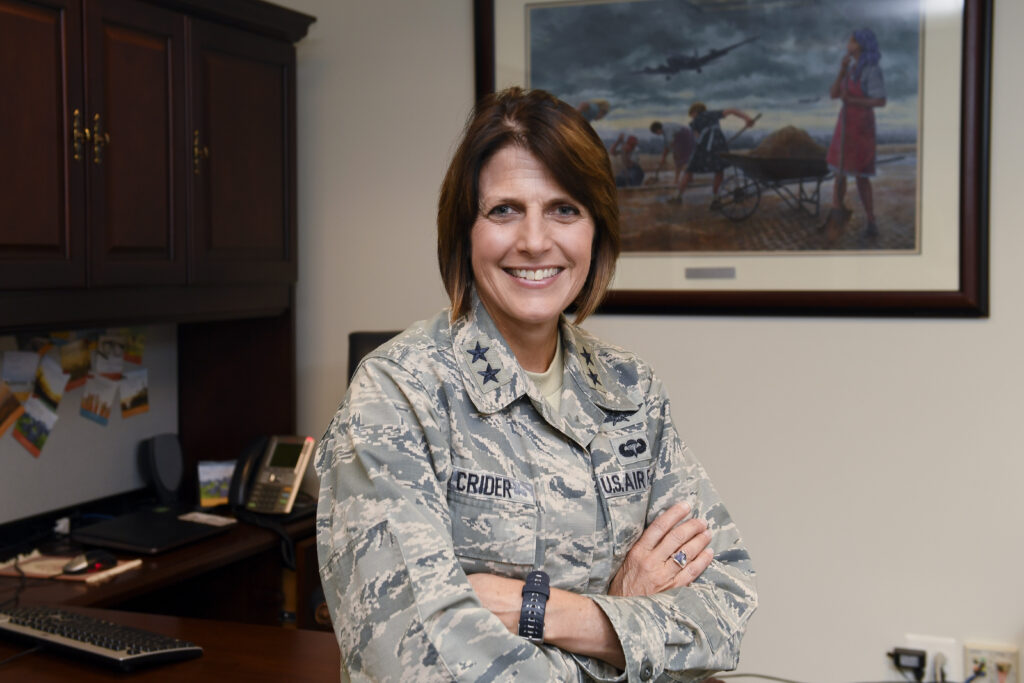
Maj. Gen. Kim Crider
WASHINGTON: The Air and Space Forces are starting to add cyber sensor data to create a comprehensive battlefield picture to underpin all-domain operations, says Maj. Gen. Kim Crider, senior mobilization advisor to Space Force chief Gen. Jay Raymond.
Adding cyber domain sensors to the dataONE library will help pinpoint how and where Russia, China and other adversaries are likely to attack US networks. The cloud-based dataONE leverages the Space Force’s Unified Data Library (UDL) of space sensor data developed by Crider in her previous job as Air Force chief data officer.
The UDL is merging all Space Force sensors, both those based in space and those on the ground (radar and telescopes) for monitoring space, “into a single unified data environment,” Crider explained during the ASCENDxSummit on future space operations this morning. That environment allows “registering all of our data sources for operational understanding of the domain, and then tagging and registering that data for access and specific information about how best to use that data, and curating that data for operational use.”
In turn, dataONE is at the heart of the Air Force’s Advanced Battle Management System (ABMS), which the service envisions as a military Internet of Things (IoT) enabling command and control (C2) of future all-domain operations, she explained.
“The Unified Data Library is a centerpiece to the dataONE capability within ABMS, recognized therefore as core to the ability to support Joint All-Domain C2. And in fact, that dataONE capability, centered on the Unified Data Library brings data from a variety of domains, not just space,” she said.
“There are significant amounts of space data assets available through the data library today, both military and commercial data sources can be accessed to authorized users, but [also] ground-based sensors, airborne sensors maritime sensors. And in fact we’re starting to bring cyber domain sensors, in federation with cyber data environments, into our overall dataONE architecture, and federated with the Unified Data Library ” she added.
Crider stressed that one of the fundamental tenets of the Space Force is that data is “paramount to space operations,” and that in turn access to space data is critical to the success of DoD’s high priority Joint All-Domain Operations (JADO) to defeat peer adversaries in future, high-tech warfare.
“Data is key to space. It’s critical to all-domain operations; it’s a centerpiece to it all. And we’re continuing to invest in that quite heavily for our own space capabilities, and partner with our joint all-domain ABMS partners to ensure that those capabilities are available for the larger problem set,” she said.
As Breaking D readers know, the next ABMS Onramp is scheduled for Aug. 30-Sept. 5, and will feature a simulated attack on US space assets and involve three combatant commands: Space Command (SPACECOM), Northern Command (NORTHCOM), and Strategic Command (STRATCOM). A third ABMS onramp later in September will support Indo-Pacific Command and SPACECOM, “connecting sensors and shooters in a geographic operational theater outside the U.S. for the first time,” according to a July 1 Air Force announcement. And, as Breaking D readers know, a fourth ABMS exercise in Europe is being designed to include NATO allies.
Crider stressed the Air Force and Space Force are working closely with Army, Navy and Marine Corps partners in developing the ABMS family of systems to implement JADC2 as the services and Joint Staff bear down on Defense Secretary Mark Esper’s order for development of a Joint Warfighting Concept to guide All-Domain Operations by the end of December.
“The Joint Staff recognized the need for Joint All-Domain C2 as a key concept within its Joint Warfighting Concept — that combatant commanders need to be able to access information from any domain, and quickly integrate that information to be able to develop insights and options for command and control decision-makers at the speed of war,” she said.
“Warfighting operations have continued to accelerate,” she added, “and in order for us to maintain a competitive advantage against our thinking adversaries and our peer adversaries, we absolutely have to be able to optimize any sensor’s information across any single domain — air, ground, sea, space, cyber, maritime, sub-maritime — and be able to quickly pull that information in via a sensor grid, be able to leverage that information through a variety of analytics on a variety of applications, and rapidly get that information, and the decisions associated with that information, to the warfighters that need to take action on it.”
From F-16s to NATO, Argentina’s moves tilt West, but ties to China to last
There are flashpoints to watch as Argentina navigates its future between the polar attractions of Washington and Beijing, including future defense deals and a deep space facility.


























